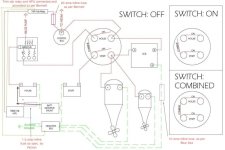Update:
Thanks to Blue Sea's great customer service, the new ACR arrived today via UPS, along with a call tag for me to send the original one back.
We got right to it and "out with the old; in with the new," plus, as long as we were at it we installed the recommended 10 amp fuse on the ground wire. I purposely haven't made any of the other changes because I didn't want to change more variables. I'm not going to be using the boat again right away, so I have some time for that going forward.
So, we had purposely not charged things up too high, because we wanted the voltage to be close to the ~12.75 that is where the ACR combines and isolates, for testing purposes. So for starters we put the charger on until the voltage got to about 12.86 and we saw that the ACR "combined." Then we turned on the GPS, VHF, and depth sounder and watched the battery monitor as the voltage dropped. When it got down to around 12.79 my buddy went out and watched the ACR like a hawk while I called out the voltage readings. Sure enough, right at around 12.75 the ACR isolated, as it should (and as the old one did). The difference being that.... nothing blew! Then we did a repeat and.... still nothing blew :thup
Now, of course we can't be 100% sure this is solved; but since the original ACR was blowing a 10 amp fuse consistently as it switched itself to "isolate" (toward the end), this is a very good sign. I feel hopeful we have solved the mystery. I think Blue Sea is going to test the original ACR, and I'm very interested in what they might find.
********
Next up: I'm going to decide whether or not I want to keep an ACR in the system, or go manual. Either way, I'm going to move the main fuse "downstream" of the switch, plus tidy up behind the helm and run a larger gauge feed wire to accommodate future draws (and then adjust the main fuse size accordingly). If I keep the ACR, I'll be adding two fuses (one in each wire, A and B), plus wiring up the start isolate feature to the engine start wiring. I have it sketched out and a list of what to acquire, but.... going to think about it a bit first.
*********
And one "oopsie!" to explain. I think it was earlier in this (book length!) thread that we talked about engine charging and SOC. I had noted that my engine seemed to get the batteries up to 100%... but from everything I had read, the charger on an outboard is really too primitive to do that (more typically it will get up to 85%, if I understand correctly).
That nagged at me, and I started going back over everything with my buddy, and finally the penny dropped: When we got out on the water, both he and I had lots to do ("new" boat/gear stuff), and he happened to be the one who calibrated the Victron (easy to do, but it's calibrating it that gives you the SOC percentage baseline). Well, he didn't realize that an outboard really never gets the batteries up to 100%, so he waited until the battery wasn't accepting any more charge (from the outboard) and then calibrated it to be full (which is basically what one does). So no wonder my outboard seemed to be that one special flower that charged like a miracle. Glad I kept the SOC up for most of the trip (so that even with the mis-calibration I was not under 50%).
So, I think we'll have to re-calibrate after my "land" charger gives it a "real" 100% charge (easy to do though).
Thanks for "coming along" on the mystery tour

I will update as/when any new information comes my way.
Sunbeam


